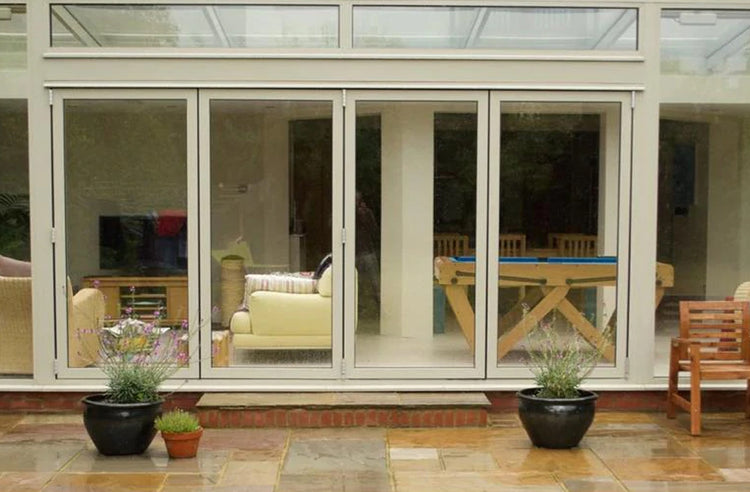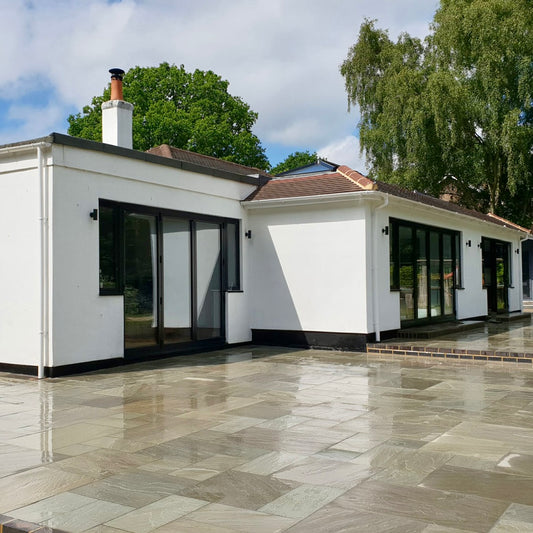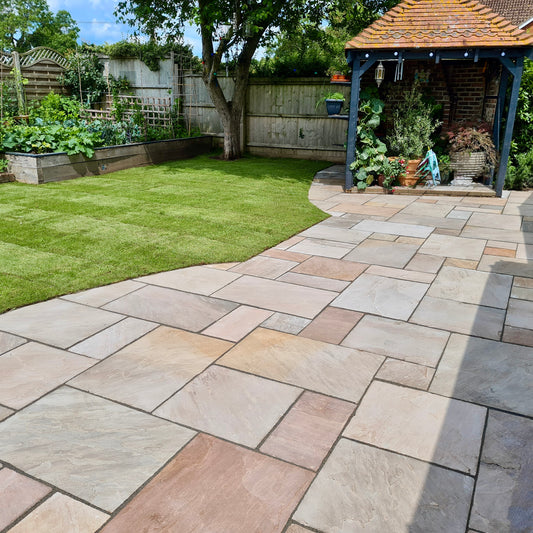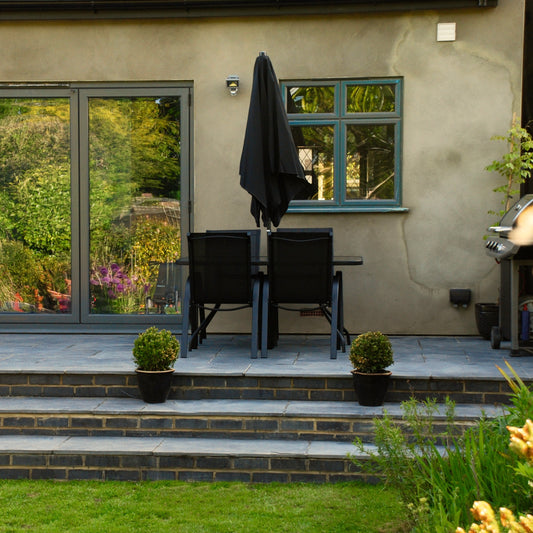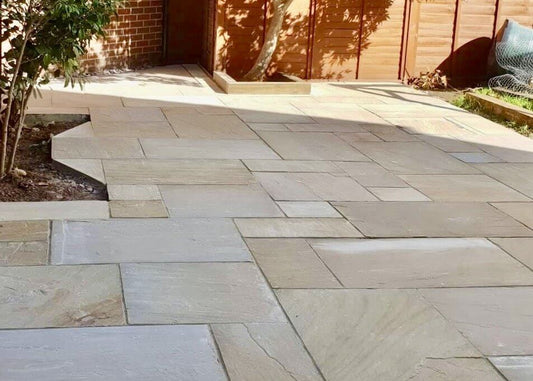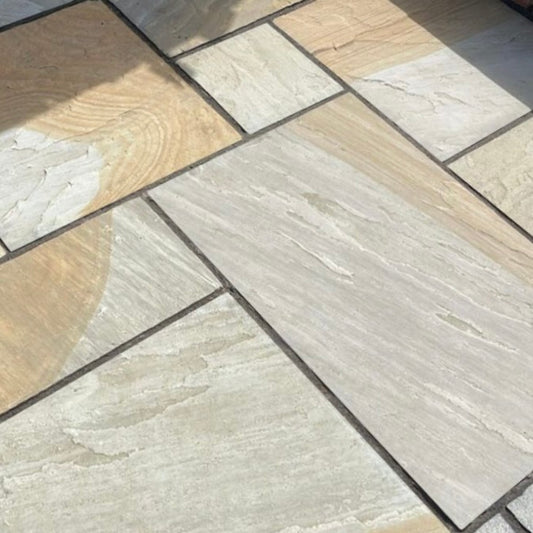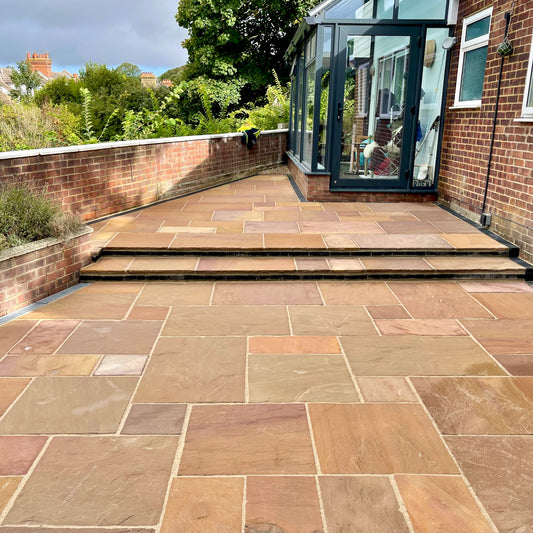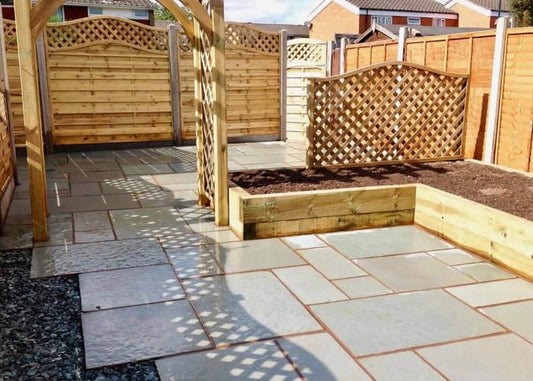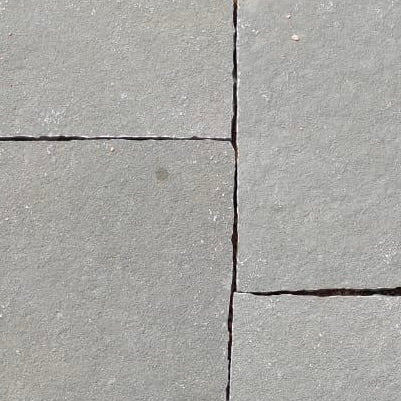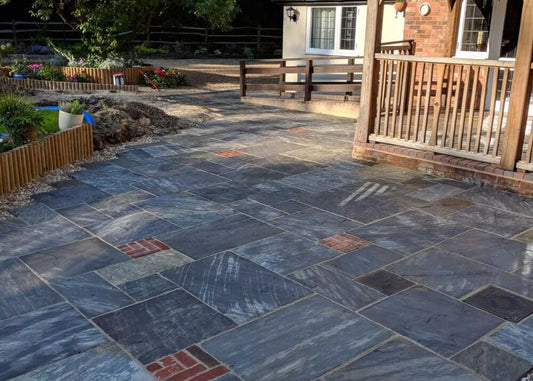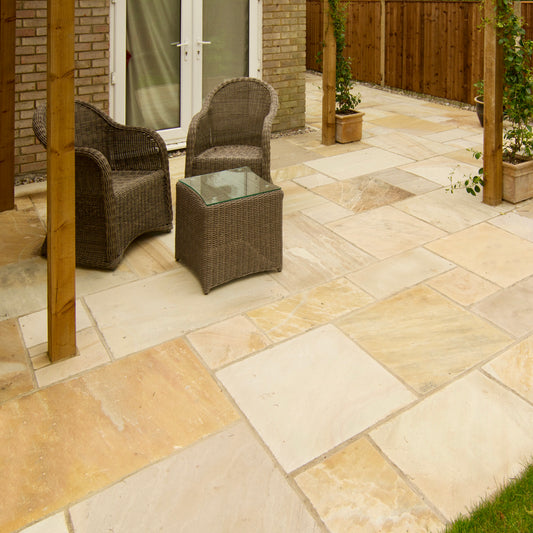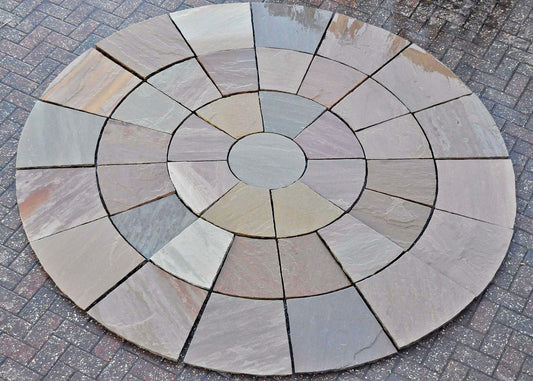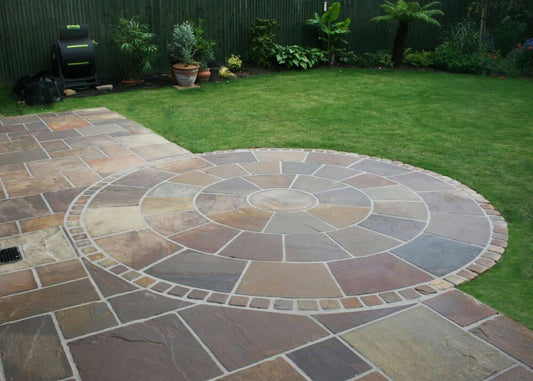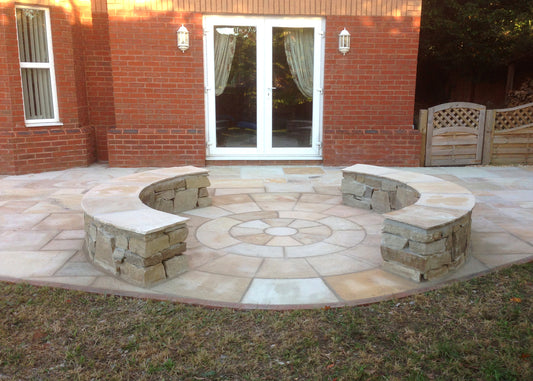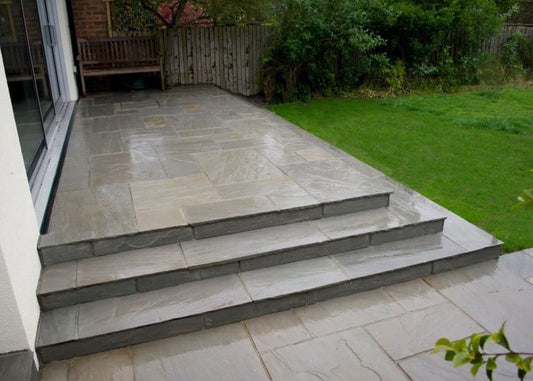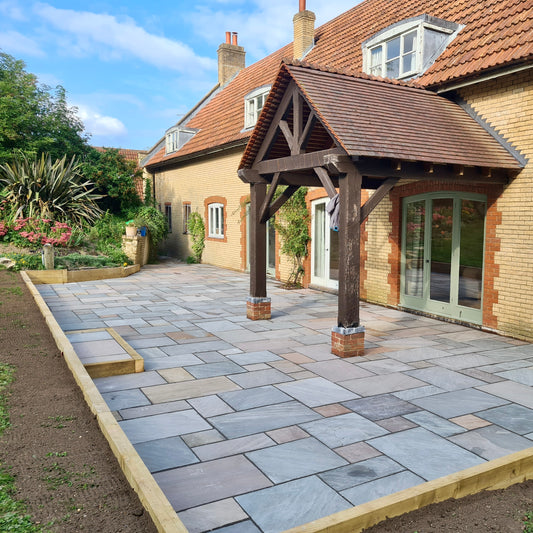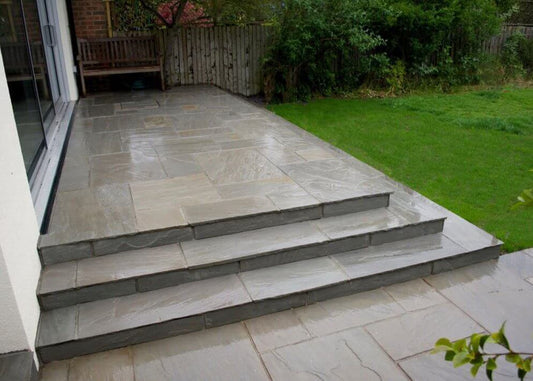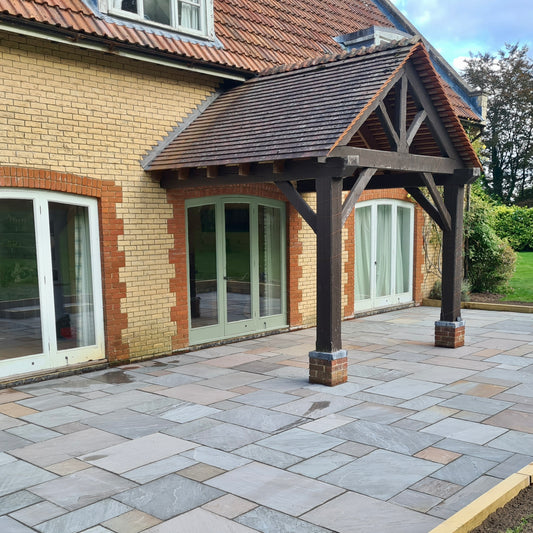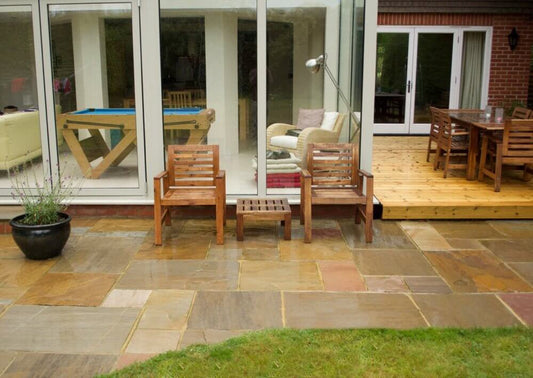Why customers love Indian stone paving
Hand split (or hand-cut) Indian sandstone is often the first choice for natural stone paving in gardens. Why? It’s strong, durable and looks great. It offers an easy way to use natural stone, providing a rustic charm to your outdoor space. And it doesn’t cost the world. Indian sandstone paving is a cost-efficient solution to your paving needs. You will find it in a wide variety of colours and finishes to suit your garden, each with the same great character and strength.
Sandstone paving, as the name suggests, is made from sandstone primarily extracted from India. Sandstone is a sedimentary rock composed of quartz grains with natural cementing materials. It’s completely natural. With subtle veining marks and patterns like cross-bedding and ripples. These are all signs that show how the rock was formed, many million years ago on the seabed.
Good quality Indian sandstone paving, with fine grains and even texture, is a long-lasting landscaping solution for walkways and patios as well as sporadic, decorative garden paving. What does this mean for you? Quite simply, you get paving that looks great and stays that way, saving you money and eliminating any hassle in the future.
Different types of Indian Sandstone Paving
Not every garden is the same – and we understand that completely. Our Indian Sandstone Paving comes in a wide range of styles. A variety of colours give you freedom when you’re planning your garden. Our most popular colours are Raj Green, Fossil Mint and Kandla Grey (a light grey Indian sandstone). We also have paving available in black and shades of brown – such as Autumn Brown – so whatever your style, you’re sure to find something perfect for your garden.
Our Indian sandstone paving comes in a range of different shapes and sizes, calibrated to just the right thicknesses. Firstly, you can choose uniform slabs for a simplistic and clean stretcher bond design. These are available in different sizes allowing you to go for big and bold or something smaller and more broken up. Alternatively, you can opt for a mixture of sizes with a more interesting random layout.
Using a mix of different colours is a great way to give your paving a fun and attractive pattern. You can also choose between hand split (hand-cut) or sawn stone.
Where to use Indian sandstone
Where should you use Indian sandstone paving? The choice is yours – it’s an incredibly versatile paving option. With a strong natural stone composition, it’s fully capable of withstanding pressure from people walking above.
Even in public spaces, Indian sandstone can be used for walkways big and small. Weather isn’t an issue. The porous quality of the Indian sandstone makes it ideal in any weather, without becoming weak or damaged.
And, of course, whatever style you choose, it’s got a unique aesthetic appeal. This makes Indian sandstone paving perfect for patios and garden areas, whether it’s for a small isolated area or a large stretch of the garden.
Indian sandstone vs. limestone
In any outdoor construction or renovation project in the house, whether it’s a driveway, garden walkway, patio, or a veranda, the most loved and commonly considered options for the finish are Indian sandstone and limestone. But deciding between the two is a tough job. Let us tell you why.
Sandstone and limestone may look very similar to the untrained eye but they have some significant differences, both in quality, feel and look. So before opting for any choice, both these options should be carefully compared and considered.
- Durability: In this category, both sandstone and limestone are almost the same. The only minimal difference may be found within the lighter-toned sandstones which are slightly more porous and thus, prone to absorb a bit more water than the darker ones. However, sandstone is harder and able to withstand heat and impact better than limestone, which may be denser but also more prone to wear and pitting.
- Aesthetic Appeal: when it comes to look and beauty, sandstone is definitely the winner. Available in a diverse range of styles, tonal variations and an extensive colour palette, sandstone gives a beautifully rustic look to the space with its coarse yet gentle enough texture. Limestone gives more of a smooth and silky finish which makes it a good option for wall veneers or summer patios.
- Texture: Compared to limestone, sandstone is more rough and uneven with a rippled texture. But sandstone’s wide variety gives you a lot of texture options to choose from. From sleek and modern to a vintage, Victorian look, sandstone textures fit all. Limestone, on the other hand, has a more flat, smooth feel with fewer ridges. This smoother texture, however, makes it unsuitable for stepping spaces requiring greater grip and slip resistance
Sandstone and limestone both have their pros and cons. But since sandstone is more versatile because of its texture and colour selection, it trumps limestone in usage. Still, you are free to opt for any option depending on your specific construction needs and overall look. Check out our limestone paving options by clicking here.
Why use natural Indian sandstone paving slabs?
No matter what kind you may use, sandstones add a stylishly sophisticated yet modernly rustic look to the whole space at very reasonable costs. Being a natural Indian stone, sandstone is very likely to age better as well (just like the quality of wine), it’s riven surface looking even more beautiful as the years go on. So old really becomes gold when natural sandstone is used in construction. It is the perfect affordable alternative to Yorkstone.
Moreover, sandstone can be trusted to stand the test of time. As it is nature’s gift, formed over a period of many years with the amalgamation of sand grains containing quartz in large quantities along with some cementing material, sandstone is much more durable and resistant to impact than other alternatives.
Indian sandstone paving is low maintenance
Durability aside, sandstone is extremely low maintenance as well. For example, you can get a sandstone patio installed and simply forget about it for a long time. It is extremely well adjusted to heavy rains and harsh weather conditions and does not fade or wear away easily. Cleaning sandstone is very easy too. You can pressure wash it without damaging the colour or finish.
Another great aspect of using Indian sandstone paving is the reduced carbon footprint. As sandstone is a naturally occurring and widely available resource, it is an easily sustainable building material and is more eco-friendly than other artificially made options.
Why choose Infinite Paving?
At Infinite Paving, we provide a wide range of high-quality paving and patio pack options. Our sandstone paving leaves no stone unturned. With different colours, styles and sizes on offer to give you exactly what you want and need. Since 2009, we have supplied high-quality natural stone paving to a wide range of customers, both private and commercial.
Our paving delivers quality every time, with long-lasting strength and an attractive appearance that’s ready to stand the test of time. It’s why our customers love us – and why they come back time and again.
Take a look at our sandstone paving options and select the one that’s right for you. Can’t find what you’re looking for? Maybe you need some advice on your choice of paving? Be sure to get in touch with our friendly team to discuss your needs further and we’ll try to point you in the right direction.

